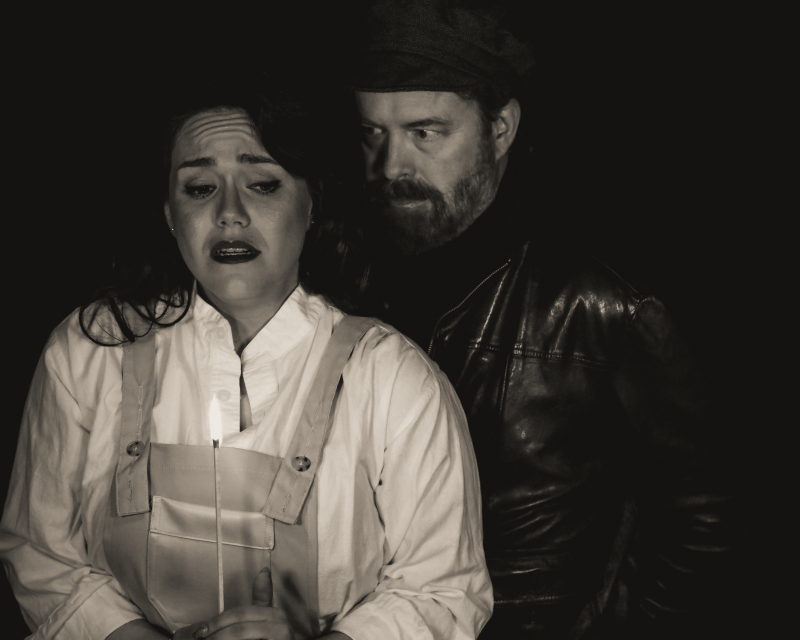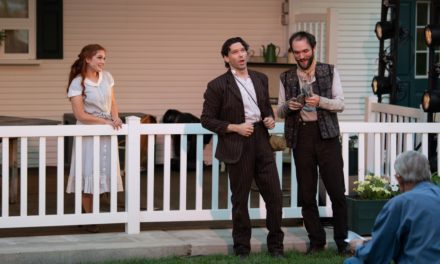PAYSON — Payson Community Theatre board member Hannah Anderson spoke warmly about twenty five years of theatre shows produced. She was insightful about the ebb and flow of fall shows being part of the company seasons, as well as the connection that the organization has had to the community. That sense of local bonding was more pronounced as Anderson could greet many patrons who came to see the Friday, November 8 showing of Wait Until Dark by Frederick Knott. Drawing together of community is one of the ways of combating darkness that that director Adam Cannon hopes audiences will find as they connect with the show.
The story, which was also famously adapted into a 1967 film featuring Audrey Hepburn, centers on Susy Hendrix. Susy was recently blinded in an accident and her husband doesn’t feel she’s capable of doing much of anything on her own. Suzy finds herself in the thick of a plot to steal a doll that has accidentally come into the possession of her husband, Sam, through a stroke of bad luck. The thieves will stop at nothing to get the doll back, and Susy has to prove she can protect herself.
Ester Slaeker who played Susy was far and away the exceptional performer in the solid cast. Slacker navigated well what I imagine the character of Susy feels. There’s a mix of uncertainty with the new challenge of blindness and stubborn resolve to do things on her own as she had before. It is a role that requires an actor to have soft focus points and express with so much of the face other than their eyes. Slacker excelled at this. She was emotionally fraught without being helpless. In her highest stakes moments, I believed the challenges she was facing, and I found myself unable to look away from the danger she was in and the subtext she created. It’s a heavy show for her as she is almost never off stage once she first enter, but Slaker was energetic and lively through the performance.
I loved Jane Champion’s portrayal of Gloria, the upstairs neighbor to Susy who is torments her very existence. Champion was sullen and derisive like a teenager without being obnoxious. She simply didn’t want to exert any effort on things until they mattered to her. I loved the way that Champion found the sense of the moment and became more sober in body and voice through those moments. However much of the show’s tension was beautifully eased when she would drop a well placed quip or joke.
Cannon’s greatest success in this production was found in finding key moments of tension in the production. While the early moments of the play felt slow, the show picked up dramatically in the second act. The ensemble seemed to be more focused on their objectives. Subtext became more pronounced, and the tension wasn’t cut too early. The scenes between Susy and the most dangerous of the thieves – Harry Roat – were quite well acted. Roat, played by Craig Gardner, started a little heavy handed in accentuating his accent, but as the play reached it’s crescendo, he was scary. Gardner’s killing in the play was simple but vicious. His sneers were full of bad intentions and while stage combat was handled well, he piqued concern for Susy early and often. Gardner’s malice as Roat and Slaeker’s terror as Susy were both severe and it made their interactions that much stronger.
There one major choice that didn’t resonate with me in the production came from the execution of the lighting. Most of Jenny Cannon’s lighting design was simple but effective, casting light in the right places and passing time with intensity and focus in the right ways. However Wait Until Dark’s iconic scene features pitch black darkness. Instead, a wash of high intensity deep red light undercut the audiences’ connection to Susy’s blindness in the moment of the play that mattered by far the most. There were already emergency lights in the auditorium space that made it easy enough to see some of the stage, and by having the red wash, it undercut the audience’s ability to be surprised by the key reveals in that scene.
On balance, this was a wonderful way to close out the spooky season. The choice to do this classic play has extra merit this time of year, though some aspects of the script no longer land. The way that Susy’s husband treats her is cringe inducing, and some of the exposition heavy set up leads to plodding pace that modern plays tend to overcome with greater ease. With special praise to Slaeker for her work as the lead, Payson has produced a show to be proud of in Wait Until Dark
Photo Credit: Mary Hansen





